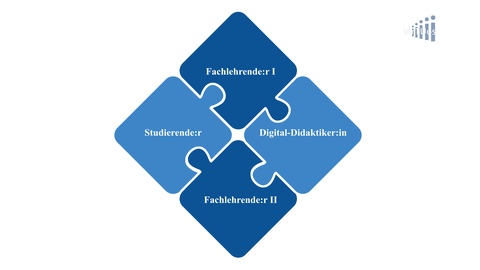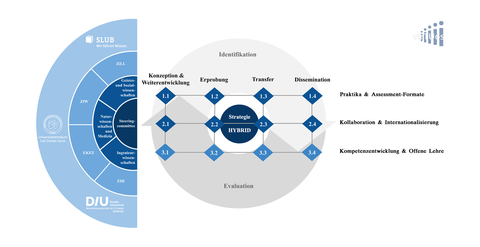2. Innovationsidee
Für die TUD ergeben sich drei primäre Handlungsfelder (Praktika- & Assessment-Formate/Kollaboration & Internationalisierung/Kompetenzentwicklung & Offene Lehre), auf denen zwei Innovations-teams im fächerübergreifenden Austausch hybride und virtuelle Lehr- und Lernformate in vier Entwicklungsschritten (Konzeption & Weiterentwicklung/Erprobung/Transfer/Dissemination) standardisieren. Die Bemühungen laufen in einer Strategie HYBRID zusammen, die durch ein Integrationsteam gleichzeitig entwickelt wie vorangetrieben wird. Dieses Team identifiziert besondere Potentiale, evaluiert getestete Lösungen und entwickelt gezielte Strategien in Bezug auf eine nachhaltige Integration (bei beschleunigter Transmission) für curriculare Realisierung und die prüfungsrechtliche Auslegung. Auf diesem Weg werden die Resultate von virTUos schnellstmöglich und breit in der Praxis verankert und somit die Qualität und Flexibilität einer hybriden Hochschullehre verbessert. Zwei Innovationsteams und das Integrationsteam werden durch das leitende Steering Committee unterstützt (Abb. 1).
Abb. 1 (hochauflösende Version): virTUos-Struktur. links: Orchestriertes Zusammenwirken der virTUos-Fachbereiche, Support- und Transferpartner:innen. rechts: Projektmatrix mit Arbeitspaketen (AP 1.1–3.4), die sich drei Handlungsfeldern (Zeilen) und vier Projektschritten (Spalten) zuordnen lassen und deren Ergebnisse in einer uni-versitätsweiten Strategie HYBRID integriert und implementiert werden.
In virTUos werden die Expertise verschiedener Fachbereiche der Universität und spezifische Kompetenzen von lokalen Transferpartner:innen (Dresden International University, DIU, Sächsische Landes-bibliothek – Staats- und Universitätsbibliothek Dresden, SLUB, und Carus Akademie am Universitätsklinikum Carl Gustav Carus Dresden, CA/UKD) einbezogen. Es gilt, ein breitgefächertes und in verschiedenen Fachkulturen getestetes Angebot virtueller wie auch hybrider Lehr- und Lernszenarien auf Dauer zu stellen. So können beständig Impulse für die digital gestützte Lehre in den zentralen Hand-lungsfeldern gegeben werden. Speziell werden tradierte Lernformate zu hybriden Arrangements weiterentwickelt und verstetigt. Darunter ist die Verschränkung realer und virtueller sowie dadurch zunehmend auch standortübergreifender (internationaler) Lernumgebungen zu verstehen, welche zu neuen Formen der Interaktion zwischen Lernenden und Lehrenden mit Hilfe innovativer Tools führen. Diese erlauben insbesondere auch die Integration und Inklusion Studierender und Lehrender mit Zugangsbeschränkungen. Den Innovationscharakter für die TUD bilden folgende handlungsleitenden Merkmale: (1) Studierende stehen im Fokus als aktive (Mit-)Gestalter:innen hybriden Lernens und Lehrens und erwerben u. a. im tutoriellen Einsatz als „lehrende Lernende“ zusätzliche Kompetenzen. (2) Innovative Lehr-Lern-Szenarien mit zunehmend internationaler Ausstrahlung werden in zwei Innovationsteams integrativ in einem fachspezifischen, auf Transfer ausgelegten Prozess entwickelt, der eine (fach-)didaktische Herangehensweise ebenso einschließt wie den fachkontextualen Einbezug von übergreifenden Digitalkompetenzen. (3) Hybrides Lernen und Lehren ist Gegenstand einer kollaborativen, strategischen Hoch-schulentwicklung an der TUD, die in der Strategie HYBRID verankert wird. Ein Integrationsteam ergänzt dabei komplementär die bereits bestehenden Unterstützungsstrukturen der TUD und adressiert Anforderungen an Reformen von Studien- und Prüfungsordnungen. (4) Im Kontext des Scholarship of Teaching and Learning werden Konzepte Offener Lehre als Open Educational Practices (OEP) interdis-ziplinär erarbeitet sowie hochschulübergreifend weiterentwickelt und genutzt.
Auf den drei genannten Handlungsfeldern, die in Abschnitt 3 (Projektvorhaben) genauer beschrieben werden, agieren die virTUos-Partner:innen in unterschiedlichen, miteinander
vernetzten Teilprojekten. Sie streben interdisziplinär und interprofessionell
innovative Lehr- und Lernszenarien mit einer Schwerpunktsetzung auf Kompetenzziele und Formate an. Sie suchen Lösungen, die eine studierendenzentrierte, interaktive
und inklusive Lehre ermöglichen und eine Wirkung über den Standort hinaus bis hin zur Stärkung internationaler Beziehungen und Studienformate entfalten. Die virTUos-
Partner:innen koordinieren aufbauend auf vorhandenen zentralen Supportstrukturen (ZiLL, ZfW, ZIH und EKFZ) in gemeinsamer (teilprojektübergreifender) Abstimmung die Zusammenarbeit auf den genannten Handlungsfeldern in agilen, interdisziplinären Innovationsteams (Abb. 2, hochauflösende Version).

Abb. 2 Struktur eines agilen interdisziplinären Innovationsteams
In diesen arbeiten immer Lehrende als Vertreter:innen mindestens zweier Fachkulturen mit konkreten Vorhaben zu hybriden bzw. digital unterstützten Lehrangeboten gemeinsam mit Studierenden und Hochschul-/Mediendidaktiker:innen zusammen. Sie verfolgen über das konkrete Lehrangebot hinaus jeweils auch die Ziele Skalierung und Transfer in andere fachliche
Kontexte. Durch diese interdisziplinären Vernetzungen werden die Handlungsfelder aufeinander bezogen.
Um die innovativen Ideen an der Universität sichtbar zu machen, entwickelt das Integrationsteam die Strategie HYBRID. Diese hat die institutionelle Verankerung und Realisierung der in virTUos erarbeiteten Lösungen (in der Studiengangsentwicklung, in prüfungsrechtlicher Auslegung und Ausgestaltung wie auch in den Curricula) in enger Absprache mit der Universitätsleitung zum Ziel. Das Integrationsteam leistet einen relevanten Beitrag zur universitätsweiten Harmonisierung digitaler Lehr- und Lern-
Ansätze und stellt die strukturelle Voraussetzung dafür dar, dass eine Kultur digitalen Lernens gestärkt wird. Es identifiziert, evaluiert und adressiert Entwicklungspotentiale auf Strategietreffen sowie in regelmäßigen Reviewtreffen mit dem Ziel, Studiengangs- und Lehrentwicklung strategisch und strukturell zu stärken. Außerdem konzipiert, erprobt und transferiert es Virtualisierungen speziell dieser Austauschformate, um nicht nur die Ergebnisse der einzelnen Vorhaben, sondern auch innovative und interaktive Formen des interdisziplinären und interprofessionellen Arbeitens inklusiv zu gestalten und international zu verbreiten. Koordiniert werden alle Teams durch ein paritätisch besetztes Steering Committee aus Lernenden und Lehrenden, das vor allem hinsichtlich Kommunikationsabläufen wie auch Prozessen, die sich aus den engen Kollaborationsbeziehungen ergeben, im Sinne eines agilen Projektmanagements
leitet und entscheidet.
< zurück weiterlesen >

